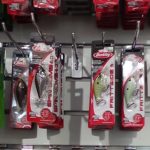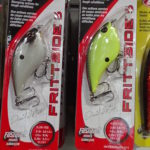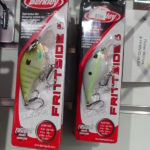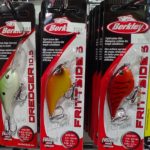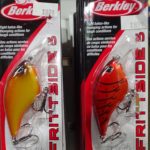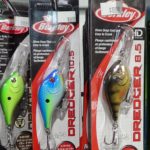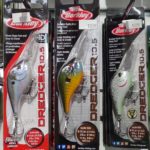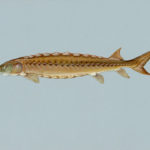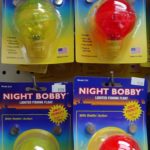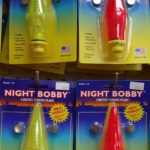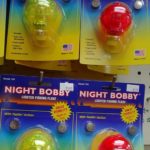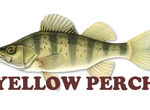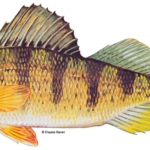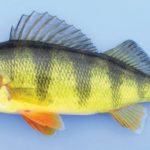A woman gets on a bus with her baby. The bus driver says: “Ugh, that’s the ugliest baby I’ve ever seen!” The woman walks to the rear of the bus and sits down, fuming. She says to a man next to her: “The driver just insulted me!” The man says: ”You go up there and tell him off. Go on, I’ll hold your monkey for you.”
Product of the Week!!!
We have some great crankbait lures by Berkley!
What are crankbait lures? Well…
A crankbait is a lure with a plastic lip that dives underwater when it is reeled in. Crankbaits are used to target fish at specific depths. The length and angle of the plastic lip is what determines the depth that the bait can reach. Longer, less-angled, lips dive deeper than short, sharp-angled, lips.
This is the perfect time for crankbait now that the water is getting colder and the bass are getting sluggish.
Berkley Frittside 5
Designed by the legendary crankbait angler, David Fritts, the Berkley Frittside Crankbait is based on the crankbait that helped David win the 1993 Bassmaster Classic. Featuring a flat sided profile that mimics a wide variety of baitfish, the Berkley Frittside Crankbait delivers a tight balsa-like thumping action and flash that is deadly during tough conditions when fish are sluggish or heavily pressured. The Frittside Crankbait is also precisely balanced to increase casting distance and provide stability when using high retrieve speeds. Armed with sticky sharp Berkley Fusion19 treble hooks that provide lightning-fast hook penetration, which is crucial for short striking and lethargic fish. Many colors, for depths of 2-5 feet.
Berkley Dredger8.5/10.5
Typically when exploring deep water with plugs, an oversized crankbait is the only option, but with the Berkley Dredger Crankbait anglers now have the ability to downsize their profile and still reach the depths needed to get that big bite. Engineered with a custom body shape and a weighted bill, the Berkley Dredger Crankbait descends quickly and stays in the strike zone longer, so anglers get the most possible attraction out of every cast. And because it is smaller than most deep diving crankbaits, the Berkley Dredger Crankbait generates less resistance, which means less fatigue throughout a full day of chucking-and-winding. Built to produce a tight, subtle action, the Berkley Dredger Crankbaits offer a slow rise on the pause, tempting fish throughout all stages of the retrieve. Many colors. Dredger 8.5 for depths of 8-10 feet. Dredger 10.5 for depths of 9-11.5 feet.
All just $8.98 at your friendly neighborhood Pipe Rack!
FISHY FACTS
Shortnose Sturgeon
The smallest of the three sturgeon species that occur in eastern North America. They inhabit rivers and estuaries. They were listed as endangered in 1967.
Shortnose sturgeon live in rivers and coastal waters from Canada to Florida. They hatch in the freshwater of rivers and spend most of their time in the estuaries of these rivers. Unlike Atlantic sturgeon, shortnose sturgeon tend to spend relatively little time in the ocean. When they do enter marine waters, they generally stay close to shore. In the spring, adults move far upstream and away from saltwater, to spawn. After spawning, the adults move rapidly back downstream to the estuaries, where they feed, rest, and spend most of their time
Shortnose sturgeon have five rows of bony plates known as scutes. This unique fish looks like it is covered in armor. Shortnose sturgeon are slow-growing and late-maturing, and they have been recorded to reach up to 4.5 feet in length and live 30 years or more.
The most popular areas for sturgeon fishing are the upper Mississippi into the Ohio and Missouri watersheds. The Great Lakes region is the most common target, though it is a huge area.
Joke of the Week!!!
Q: How do you get a country girl’s attention?
A: A tractor.
Product of the Week!!!
We have 10 NEW 2.5 oz. Smoke Odor Exterminator Sprays!!!
If you don’t know about them, Smoke Odor Exterminator Sprays and Candles are formulated with natural odor neutralizing enzymes that destroy odors rather than just masking them. The enzymes absorb the odor from their surroundings into the product, then the enzymes break down the odor’s compound structure, and evaporate the by-product in the form of a clean, natural gas. During the evaporation process, the gas picks up the scent of the product and releases this fragrance into your office, home or car — exterminating the odor and creating a pleasant fragrance for your enjoyment. It’s what makes these products uniquely different from other air fresheners on the market.
Our 10 new fragrances are…
Rasta Love – A sweet and spicy mix of valencia oranges, coconuts, cloves, violet petals, sandalwood, golden amber, patchouli, and creamy vanilla.
Happy Daze – Bursting with fruitiness, it’s a sweet blend of lemon, mango, peach, mandarin candy, pineapple, wild melon, and vanilla.
Orange Lemon Splash – A unique blend of sweet oranges with a splash of tangy lemons. A sweetened, fresh, and exotic intermingling of citrus fragrances.
Pineapple Coconut – A tropical fragrance, which is a deliciously balanced blend of juicy pineapple and creamy coconut.
Clothesline Fresh – A scent that reminds you of beautiful blue Spring skies, crisp Spring air, and the fresh, clean smell of laundry, sun-drying on the clothesline.
Hippie Love – A sweet, entrancing, and fragrant combination of tropical fruits with just a hint of spice, watermelon, and tropical fruit punch.
Lavender with Chamomile – An aroma of crisp lavender, infused with chamomile. A sweet, floral fragrance.
Trippy Hippie – A sweet and tart mix of Valencia orange, sour lemon peel, and a splash of jasmine, topped off with a sprinkle of sugar.
Sugar Skull – A men’s cologne fragrance with notes of lavender, sandalwood, and spices.
Nag Champa – A blending of frangipani and sandalwood scents. Nag Champa is one of the most popular scents.
All just $4.50!!!
Right here at your friendly neighborhood Pipe Rack!!!
FISHY FACTS
Tardigrade:
Tardigrades may be the toughest animals on Earth. They have evolved to live almost anywhere and survive almost anything. Some tardigrades can shrug off conditions that would obliterate most living beings, including extremes far beyond anything found on Earth.
They are also tiny, rotund, and strangely endearing, with nicknames like “water bear” and “moss piglet.”
1. They’re Microscopic, But Just Barely
Tardigrades are near the edge of visibility for most human eyes. A typical tardigrade is about 0.5 mm (0.02 inch) long, and even the largest ones are less than 2 mm (0.07 inch) in length. Some larger tardigrades can be visible to the naked eye, but since they’re also see-through, we’re unlikely to get a good view without at least a low-power microscope.
2. They Are Their Own Phylum
Tardigrades comprise an entire phylum of life, which is one taxonomic rank below kingdom.
Tardigrades have been around for at least 500 million years or so, possibly sharing a common ancestor with arthropods. Over 1,000 species are known today, including marine, freshwater, and terrestrial tardigrades.
3. Their Bodies Are Like Walking Heads
At some point early in their lineage, tardigrades lost several genes involved with producing the head-to-tail body form of animals during development. They have lost a large intermediate region of the body axis, too, lacking segments that, in insects, correspond to the entire thorax and abdomen. According to a 2016 study published in Cell Biology, the tardigrade’s body now seems to be made mainly from head segments, making its entire body “homologous to just the head region of arthropods.”
4. They Can Go Decades Without Food or Water
Perhaps the most famous thing about tardigrades is their uncanny durability. Tardigrades are not immortal, but they have a powerful adaptation that allows them to survive for decades in extreme conditions: cryptobiosis.
To endure environmental stress, tardigrades suspend their metabolism through a process called cryptobiosis. They curl up and enter a death-like state known as a tun. Their metabolism slows to 0.01% of normal, and their water content drops to less than 1%. They survive in this state by replacing the water in their cells with a protective sugar called trehalose, which preserves all the cellular machinery until water is available again.
Tardigrades have different kinds of tun states for different hardships. Anhydrobiosis helps them survive desiccation, for example, while cryobiosis protects against deep freezes. Tardigrades can survive long periods without food or water in a tun, then return to normal once they’re rehydrated. Some have been reanimated from a tun after lying dormant for 30 years.
Outside of their tun state, tardigrades have a lifespan of up to two and a half years.
5. They Perform Well Under Pressure
Some tardigrades in a tun can handle pressure as high as 600 megapascals (MPa). That’s nearly 6,000 atmospheres, or 6,000 times the pressure of Earth’s atmosphere at sea level, and it’s about six times higher than the pressure found in the planet’s deepest ocean trenches. Even half as much pressure, 300 MPa, would kill most multicellular life and bacteria.
6. They’re the First Animal Known to Survive in Outer Space
Two tardigrade species flew into low-Earth orbit on the FOTON-M3 mission in 2007, becoming the first animals known to survive direct exposure to space.5 The 12-day mission included active and desiccated tardigrades, exposing some of each group to either the vacuum of space, the radiation, or both. Exposure to the vacuum was no problem for either species, and the lack of gravity had little effect, either. Some tardigrades even laid eggs during the mission. They were not impervious, though, and the combined effects of the vacuum and UV radiation did take a toll.
Tardigrades also visited the International Space Station in 2011, with similar results pointing to an incredible tolerance of the space environment. In 2019, when the Beresheet probe crashed on the moon, a capsule containing tardigrades in a tun state may have survived the impact, scientists announced. The fate of the tardigrades remains unclear, but even if they are still up there, they can’t reanimate without liquid water.
7. They’re Resistant to Radiation
Research has shown tardigrades can survive roughly 1,000 times more radiation than a human. They often resist the damage of radiation exposure in both active (hydrated) and tun (desiccated) states, which researchers have noted is a little surprising since the indirect effects of ionizing radiation are expected to be much higher in the presence of water.7 Being in a tun does seem to confer more protection, though.
Tardigrades have not only survived massive irradiation; they’ve also gone on to produce healthy offspring following radiation exposure. Researchers believe this is due to tardigrades’ abilities to both avoid the accumulation of DNA damage and to efficiently repair the damage that has been done. Still, as some space experiments have shown, even tardigrades have a limit for how much radiation they can take.
8. They Aren’t Picky About Temperature
Polar tardigrades have survived cooling down to minus 196 degrees Celsius (minus 320 Fahrenheit), and research suggests some might be able to withstand temperatures down to minus 272 C (minus 458 F), or just one degree above absolute zero. More heat-tolerant species, on the other hand, can survive temperatures as high as 151 C (300 F).
Joke of the Week!!!
I used to be addicted to the hokey pokey but then I turned myself around.
Product of the Week!!!
Night Bobby Light Float with Rattlin’ Action
Increase your chances of bringing a prized catch home with the Night Bobby Lighted Fishing Float in your accessory kit. Night Bobby floats are powered by two 1.5 volt button cell batteries. Batteries included. This item is suited for day or night use and can increase your water visibility up to 200 feet. Its new light diffusion pattern also gives it a natural glow that does not turn off gamefish and, instead, lures them in. The Night Bobby lighted floats are made of high-impact polycarbonate. The shock-resistant light emitting diode will never need replacement. When using a Night Bobby all you have to do is lightly jerk the line and its rattling sound carries under water to attract fish as well. Using this night fishing float is also easy, since the float can be removed without cutting the line and removing the bait, hook or sinker. It also allows the line to slip in freely and locks it securely.
Small and Large
Round and Torpedo Night Bobbys
in Red and Chartreuse.
All for just $5.98 each!
Right here at your friendly neighborhood Pipe Rack!
FISHY FACTS
Yellow Perch:
If you want to catch some yellow perch, you don’t have to drive to Lake Erie to fill a cooler. Upground reservoirs, a type of artificial inland lake, offer excellent yellow perch fishing if you know where to go and how to catch them. Yellow perch can be caught in upground reservoirs using techniques similar to those proven effective in Lake Erie. Upground reservoirs with the best yellow perch fishing are primarily located in Northwestern Ohio.
TIPS: The key to catching yellow perch is finding the right location. You must find where the fish are holding and feeding at each time of the year to be successful.
Some anglers use fish finders (sonar) to locate yellow perch. However, they can be difficult to see on a fish finder when they are lying on or close to the bottom. A popular technique to locating them is drifting or slow trolling until you catch one, then anchor immediately and fish straight down.
Yellow perch also like to associate close to structure. Most upground reservoirs do not have much vegetation, but if you find some rooted vegetation, try fishing along its edge. If you find submerged trees near shore, they may be worth trying as well.
Choosing a rod that can provide good feel is important. Yellow perch bites can be expected to be light, so tackle should be light.
Remember, if you are not catching these fish, be flexible and try changing locations, using other baits, or choosing a different time of day to fish. You may find that yellow perch have developed a pattern of feeding at a particular time in a particular reservoir.
TACKLE: Use a light spinning rod and reel with 6-8 pound test during most of the year and ice fishing rods and gear during winter.
SEASON: Fall (mid-September-November)
PEAK ACTIVITY: Excellent
PRESENTATION: Slow drift or slow troll from boat. After you catch one; anchor at that location. Fish straight down just off the bottom using small minnows fished with a spreader or crappie rig.
Joke of the Week!!!
I watched hockey before it was cool.
They were basically swimming.


